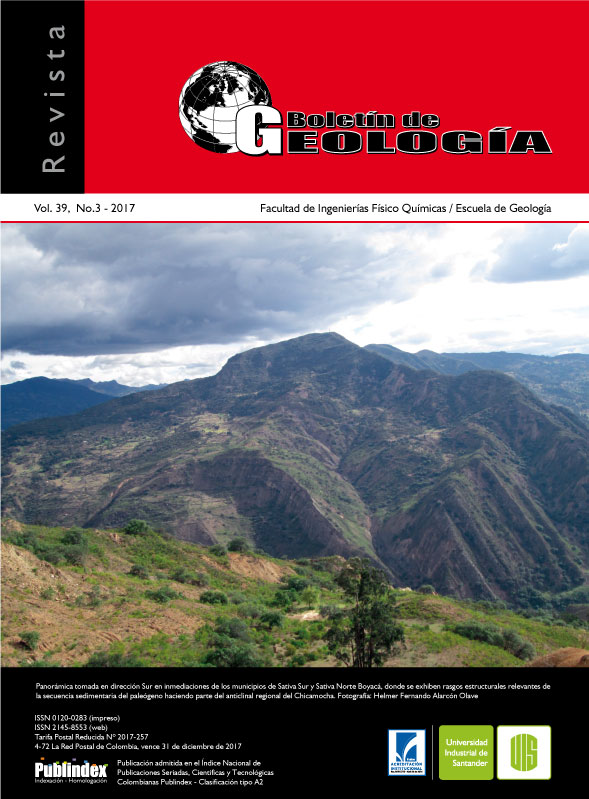NUMERICAL TOOL FOR THE EVALUATION OF TWO PHASE DISPLACEMENTS IN POROUS MEDIA USING COMPUTERIZED TOMOGRAPHY
Published 2017-10-06
Keywords
- Computerized tomography of rocks,
- two-phase displacement,
- improved recovery,
- numerical algorithms
How to Cite
Altmetrics
Abstract
The annual production of crude oil in Colombia has increased, from year to year, to 367 million barrels per year and a proven reserve of 2002 million barrels in 2016. This is due to the intensified production of mature, and heavy crude, oil fields and the use of Enhanced Oil Recovery Techniques (EOR). These seek to reduce the saturation of crude oil in a reservoir by injecting fluids such as solvents, polymers, steam and air, mainly. The percentage of recovery in Colombia achieved with EOR techniques is close to 21%. However, its effectiveness depends on: the characteristics of the oil present in the reservoir, the thrust mechanism prevailing in this, pressure, and temperature, in addition to the petrophysical properties of the rock that forms the reservoir. This work deals with the estimation of the dynamic petrophysical properties of rock samples from the producer horizon using Computed Tomography (CT). For this, a set of five numerical algorithms is proposed for the estimation of the effective porosity, saturation, forward front, trapped volume, and recovery factor during the displacement of two liquids, crude and water, inside the porous medium. The purpose of the dynamic characterization using CT is to understand and analyze the parameters that influence the success of crude oil displacement in a porous medium as part of an improved production scheme in mature, and heavy crude, oil fields.
Downloads
References
API RP-40. Recommended Practices for Core Analysis. Section 1- Planning a Coring Program. American Petroleum Institute. 1998.
Bansal, A., and Islam, M.R. 1991. State-of-the-art review of nondestructive testing with computer-assisted tomography. International Arctic Technology Conference. Society of Petroleum Engineers. Anchorage, Estados Unidos, pp. 523-534.
Blau, S., Robertson, S., and Johnstone, M. 2008. Disaster victim identification: new applications for postmortem computed tomography. Journal of Forensic Sciences, 53(4): 956-961.
Borkan, G.A., Hults, D.E., Gerzof, S.G., Robbins, A.H., and Silbert, C.K. 1983. Age changes in body composition revealed by computed tomography. Journal of Gerontology, 38(6): 673-677.
Buzug, T.M. 2008. Computed Tomography: From photon statistics to modern cone-beam CT. Springer. Leipzig, 522p.
Castro, R., Maya, G., Mercado, D., Trujillo, M., Soto, C., Pérez, H., Lobo, A., Ordóñez, A., and Sandoval, J.E. 2010. Enhanced Oil Recovery (EOR) Status - Colombia. SPE Latin American and Caribbean Petroleum Engineering Conference, Lima, Peru. SPE-139199-MS.
Cozzini, C., Olesinski, S., and Harding, G. 2012. Modeling scattering for security applications: A multiple beam X-Ray Diffraction Imaging system. IEEE Nuclear Science Symposium and Medical Imaging Conference, Anaheim, Estados Unidos, pp. 74-77.
Fajardo, R.J., and Müller, R. 2001. Three‐dimensional analysis of nonhuman primate trabecular architecture using micro‐computed tomography. American Journal of Physical Anthropology, 115(4): 327-336.
Hackley, P.C., Urbani, F., Karlsen, A.W., and Garrity, C.P. 2006. Mapa geológico de Venezuela a Escala 1:750.000. USGS.
Hunt, P., Engler, P., and Bajsarowicz, C. 1988. Computed tomography as a core analysis tool: Applications, instrument evaluation, and image improvement techniques. Journal of Petroleum Technology, 40(9): 1203-1210.
Kantzas, A. 1990. Investigation of physical properties of porous rocks and fluid flow phenomena in porous media using computer assisted tomography. In Situ, 14(1): 77-132.
Kellinghaus, M., Schulz, R., Vieth, V., Schmidt, S., Pfeiffer, H., and Schmeling, A. 2010. Enhanced possibilities to make statements on the ossification status of the medial clavicular epiphysis using an amplified staging scheme in evaluating thin-slice CT scans. International Journal of Legal Medicine, 124(4): 321-325.
Meyer, R.F., Attanasi, E.D., and Freeman, P.A., 2007. Heavy oil and natural bitumen resources in geological basins of the world: U.S. Geological Survey Open-File Report 2007-1084.
OPEC. 2016. OPEC - Oil data: upstream. Consultado el 1 de diciembre de 2016. http://asb.opec.org/index.php/interactive-charts/oil-data-upstream
Owen, N., Inderwildi, O., and King, D. 2010. The status of conventional world oil reserves-Hype or cause for concern?. Energy Policy, 38(8): 4743-4749.
Pani, S., Cook, E., Horrocks, J., George, L., Hardwick, S., and Speller, R. 2009. Modeling an energy-dispersive X-ray diffraction system for drug detection. IEEE Transactions on Nuclear Science, 56(3): 1238-1241.
SGC. 2015. Mapa Geológico de Colombia. Servicio Geológico Colombiano. Consultado el 01 de diciembre de 2016. http://geoportal.sgc.gov.co/geoportalsgc/catalog/main/home.page
Shameem, S., and Khamees, A. 2004. Dual-Energy CT-Scanning Applications in Rock Characterization. SPE Annual Technical Conference and Exhibition. Houston, Estados Unidos, pp. 26-29.
Shannon, C. E. 1949. Communication in the presence of noise. Proceedings of the IRE, 37(1): 10-21.
Smith, F. 1999. Industrial Applications of X-Ray Diffraction. CRC Press. Nueva York, 1006p.
Speight, J.G. 1997. Petroleum chemistry and refining. CRC Press. Nueva York, 350p.
Strecker, H. 1998. Automatic detection of explosives in airline baggage using elastic X-ray scatter. MedicaMundi, 42(2): 30-33.
Tafforeau, P., Boistel, R., Boller, E., Bravin, A., Brunet, M., Chaimanee, Y., and Kay, R.F. 2006. Applications of X-ray synchrotron microtomography for non-destructive 3D studies of paleontological specimens. Applied Physics A, 83(2): 195-202.
Thali, M.J., Taubenreuther, U., Karolczak, M., Braun, M., Brueschweiler, W., Kalender, W., and Dirnhofer, R. 2003a. Forensic microradiology: Micro-Computed Tomography (Micro-CT) and analysis of patterned injuries inside of bone. Journal of Forensic Sciences, 48(6): 1336-1342.
Thali, M. J., Yen, K., Schweitzer, W., Vock, P., Ozdoba, C., and Dirnhofer, R. 2003b. Into the decomposed body-forensic digital autopsy using Multislice-Computed Tomography. Forensic Science International, 134(2): 109-114.
Uda, M., Demortier, G., and Nakai, I. 2005. X-rays for Archaeology. Amsterdam, Dordrecht, The Netherlands. Springer, 301p.
Wellington, S.L., and Vinegar, H.J. 1987. X-ray computerized tomography. Society of Petroleum Engineers, 39(8): 885-898.
Wheeler, J.O., Hoffman, P.F., Card, K.D., Davidson, A., Sanford, B.V., Okulitch, A.V., and Roest, W.R. 1996. Geological Map of Canada, Map D1860A, Geological Survey of Cannada, Ottawa, Ontario.
Withjack, E.M. 1988. Computed tomography for rock-property determination and fluid-flow visualization. SPE Formation Evaluation, 3(4): 696-704.
